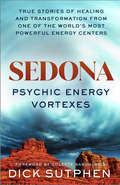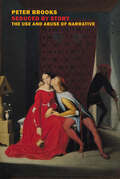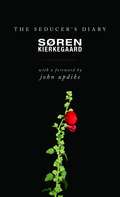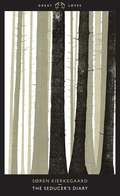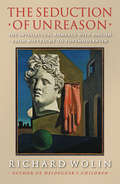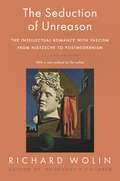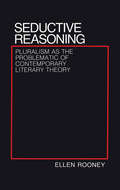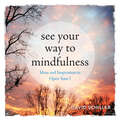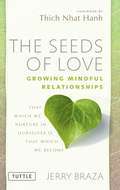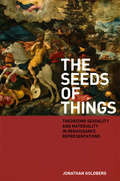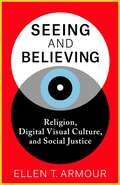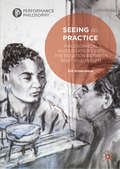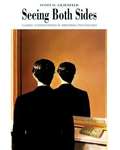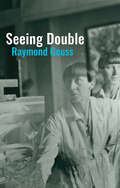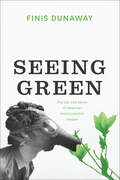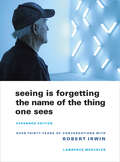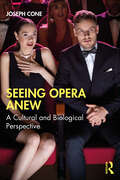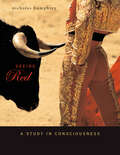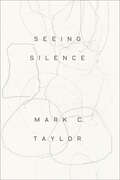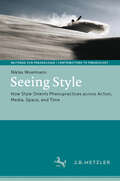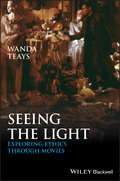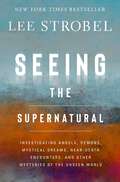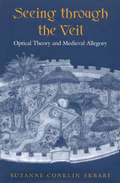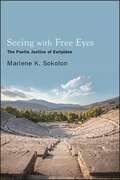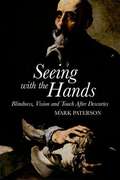- Table View
- List View
Sedona, Psychic Energy Vortexes: True Stories of Healing and Transformation from One of the Worlds Most Powerful Energy Centers
by Dick SutphenRenowned psychic researcher Dick Sutphen reveals everything readers need to know about Sedona, a hot spot of powerful cosmic energies that can call in spiritual visions, past-life experiences, and healing.&“Sedona, Arizona—a place of awesome beauty and an extraordinary energy that is felt by every person wandering through its red-rock canyons. The first time I saw Sedona, in 1969, I knew this was a special place, not only because of its magnificent beauty but because of an undeniable spiritual vibration emanating throughout the area. Over the years I&’ve become convinced, through my own experiences and the experiences of others, and through extensive research and investigation, that the psychic energy here is greater than anywhere else in the country.&”Thousands of people have had incredible metaphysical experiences in Sedona, including direct contact with spirits, visions, and manifestations. Sedona lies on ley lines connecting to Stonehenge and other spiritual power places in the world, and is surrounded by four powerful energy centers, or vortexes, all within a few miles of each other. In this book, you will learn how the vortexes are charged and how they can affect you. You will hear firsthand testimonials from people who have explored the vortexes, and remarkable stories describing their profound, life-changing encounters. Complete directions to find each vortex are also included, as well as important warnings and safeguards you need to be aware of before exploring. You will learn how to test the energy, then activate and expand it to maximize the psychic potentials of your own vortex experience. Foreword by Colette Baron-Reid
Seduced by Story: The Use and Abuse of Narrative
by Peter BrooksIn this spiritual sequel to his influential Reading for the Plot, Peter Brooks examines the dangerously alluring power of storytelling.&“There&’s nothing in the world more powerful than a good story. Nothing can stop it. Nothing can defeat it.&” So begins the scholar and literary critic Peter Brooks&’s reckoning with today&’s flourishing cult of story. Forty years after publishing his seminal work Reading for the Plot, his important contribution to what came to be known as the &“narrative turn&” in contemporary criticism and philosophy, Brooks returns to question the unquestioning fashion in which story is now embraced as an excuse or explanation and the fact that every brand or politician comes equipped with one. In a discussion that ranges from The Girl on the Train to legal argument, Brooks reminds us that among the powers of narrative is the power to deceive.
The Seducer's Diary
by Søren Kierkegaard"In the vast literature of love, The Seducer's Diary is an intricate curiosity--a feverishly intellectual attempt to reconstruct an erotic failure as a pedagogic success, a wound masked as a boast," observes John Updike in his foreword to Søren Kierkegaard's narrative. This work, a chapter from Kierkegaard's first major volume, Either/Or, springs from his relationship with his fiancée, Regine Olsen. Kierkegaard fell in love with the young woman, ten years his junior, proposed to her, but then broke off their engagement a year later. This event affected Kierkegaard profoundly. Olsen became a muse for him, and a flood of volumes resulted. His attempt to set right, in writing, what he feels was a mistake in his relationship with Olsen taught him the secret of "indirect communication." The Seducer's Diary, then, becomes Kierkegaard's attempt to portray himself as a scoundrel and thus make their break easier for her. Matters of marriage, the ethical versus the aesthetic, dread, and, increasingly, the severities of Christianity are pondered by Kierkegaard in this intense work.
The Seducer's Diary (Penguin Great Loves)
by Soren KierkegaardJohannes is an aesthete, dedicated to creating the possibility of seduction through the careful manipulation of young women. He stealthily pursues the innocent Cordelia until she becomes increasingly drawn to him. But when she is ready to give herself completely, she realizes she may have got everything wrong. United by the theme of love, the writings in the Great Loves series span over two thousand years and vastly different worlds. Readers will be introduced to love’s endlessly fascinating possibilities and extremities: romantic love, platonic love, erotic love, gay love, virginal love, adulterous love, parental love, filial love, nostalgic love, unrequited love, illicit love, not to mention lost love, twisted and obsessional love….
The Seduction of Unreason: The Intellectual Romance with Fascism from Nietzsche to Postmodernism
by Richard WolinFifteen years ago, revelations about the political misdeeds of Martin Heidegger and Paul de Man sent shock waves throughout European and North American intellectual circles. Ever since, postmodernism has been haunted by the specter of a compromised past. In this intellectual genealogy of the postmodern spirit, Richard Wolin shows that postmodernism's infatuation with fascism has been widespread and not incidental. He calls into question postmodernism's claim to have inherited the mantle of the left--and suggests that postmodern thought has long been smitten with the opposite end of the political spectrum.In probing chapters on C. G. Jung, Hans-Georg Gadamer, Georges Bataille, and Maurice Blanchot, Wolin discovers an unsettling commonality: during the 1930s, these thinkers leaned to the right and were tainted by a proverbial "fascination with fascism." Frustrated by democracy's shortcomings, they were seduced by fascism's grandiose promises of political regeneration. The dictatorships in Italy and Germany promised redemption from the uncertainties of political liberalism. But, from the beginning, there could be no doubting their brutal methods of racism, violence, and imperial conquest.Postmodernism's origins among the profascist literati of the 1930s reveal a dark political patrimony. The unspoken affinities between Counter-Enlightenment and postmodernism constitute the guiding thread of Wolin's suggestive narrative. In their mutual hostility toward reason and democracy, postmodernists and the advocates of Counter-Enlightenment betray a telltale strategic alliance--they cohabit the fraught terrain where far left and far right intersect.Those who take Wolin's conclusions to heart will never view the history of modern thought in quite the same way.
The Seduction of Unreason: The Intellectual Romance with Fascism from Nietzsche to Postmodernism, Second Edition
by Richard WolinEver since the shocking revelations of the fascist ties of Martin Heidegger and Paul de Man, postmodernism has been haunted by the specter of a compromised past. In this intellectual genealogy of the postmodern spirit, Richard Wolin shows that postmodernism’s infatuation with fascism has been extensive and widespread. He questions postmodernism’s claim to have inherited the mantle of the Left, suggesting instead that it has long been enamored with the opposite end of the political spectrum. Wolin reveals how, during in the 1930s, C. G. Jung, Hans-Georg Gadamer, Georges Bataille, and Maurice Blanchot were seduced by fascism's promise of political regeneration and how this misapprehension affected the intellectual core of their work. The result is a compelling and unsettling reinterpretation of the history of modern thought. In a new preface, Wolin revisits this illiberal intellectual lineage in light of the contemporary resurgence of political authoritarianism.
Seductive Reasoning: Pluralism as the Problematic of Contemporary Literary Theory
by Ellen RooneySeductive Reasoning takes a provocative look at contemporary Anglo-American literary theory, calling into question the critical consensus on pluralism's nature and its status in literary studies. Drawing on the insights of Marxist and feminist critical theory and on the works of Althusser, Derrida, and Foucault, Rooney reads the pluralist’s invitation to join in a "dialogue" as a seductive gesture. Critics who respond find that they must seek to persuade all of their potential readers. Rooney examines pluralism as a form of logic in the work of E. D. Hirsch, as a form of ethics for Wayne Booth, as a rhetoric of persuasion in the books of Stanley Fish. For Paul de Man, Rooney argues, pluralism was a rhetoric of tropes just as it was, for Fredric Jameson, a form of politics.
See Your Way to Mindfulness: Ideas and Inspiration to Open Your I
by David SchillerSeeing, really seeing, is like meditation. In a world filled with distraction, seeing mindfully is a way to pay attention, to hit pause and find calm by focusing on what’s directly in front of us. See Your Way to Mindfulness is a gift book of inspiration and instruction to help readers open their eyes—and their “I’s.” <P><P>Written by David Schiller, author of the national bestseller The Little Zen Companion, it’s a collection of quotes, prompts, exercises, meditations—married with photographs and drawings that bring the words to life. The quotes are from artists, Buddhists, philosophers, poets, and more, all centered on the theme of how “The real voyage of discovery consists not in seeking new landscapes, but in having new eyes” (Marcel Proust). <P>The short, playful exercises and prompts—like Seeing in the Rain, Eye Spy with My Open I, Spend 30 Minutes Taking a Five-Minute Walk, Get Lost—are designed to disrupt routine and inspire readers to see for themselves. Some of the exercises involve drawing, writing, and taking photographs, opening a path to creativity as well as showing how to engage in the moment. <P>Think of it as the Zen of seeing—a new way to look at the world afresh and rediscover joy in the everyday.
The Seeds of Love
by Thich Nhat Hanh Jerry BrazaUsing the garden as metaphor, The Seeds of Love offers a process for creating mindfulness. Through the development of the practice of mindfulness, and using its tools to maintain a state of awareness and openness to self and others. Readers will learn how to nurture such seeds as compassion, joy and generosity and to use personal challenges such as jealousy, anger and self doubt as a means of growth. Using precepts from many faiths and traditions, The Seeds of Love fosters the practice of using simple, basic actions to reach the best within ourselves and share it with those around us. It will be an invaluable guide to anyone seeking deeper and more conscious relationships.
The Seeds of Things: Theorizing Sexuality and Materiality in Renaissance Representations
by Jonathan GoldbergThe title of this book translates one of the many ways in which Lucretius names the basic matter from which the world is made in De rerum natura. In Lucretius, and in the strain of thought followed in this study, matter is always in motion, always differing from itself and yet always also made of the same stuff. From the pious Lucy Hutchinson’s all but complete translation of the Roman epic poem to Margaret Cavendish’s repudiation of atomism (but not of its fundamental problematic of sameness and difference), a central concern of this book ishow a thoroughgoing materialism can be read alongside other strains in the thought of the early modern period, particularly Christianity.A chapter moves from Milton’s monism to his angels and their insistent corporeality. Milton’s angels have sex, and, throughout, this study emphasizes the consequences for thinking about sexuality offered by Lucretian materialism. Sameness of matter is not simply a question of same-sex sex, and the relations of atoms in Cavendish and Hutchinson are replicated in the terms in which they imagine marriages of partners who are also their doubles. Likewise, Spenser’s knights in the 1590 Faerie Queene pursue the virtues of Holiness, Temperance, and Chastity in quests that take the reader on a path of askesis of the kind that Lucretiusrecommends and that Foucault studied in the final volumes of his history of sexuality.Although English literature is the book’s main concern, it first contemplates relations between Lucretian matter and Pauline flesh by way of Tintoretto’s painting The Conversion of St. Paul. Theoretical issues raised in the work of Agamben and Badiou, among others, lead to a chapter that takes up the role that Lucretius has played in theory, from Bergson and Marx to Foucault and Deleuze.This study should be of concern to students of religion, philosophy, gender, and sexuality, especially as they impinge on questions of representation.
Seeing and Believing: Religion, Digital Visual Culture, and Social Justice
by Ellen T. ArmourSocial media platforms are often denounced as “bubbles” or “echo chambers.” In this view, what we see tends to reinforce what we already believe, and what we already believe shapes what we see. Yet social movements such as Black Lives Matter rely heavily on the widespread dissemination of digital photographs and videos through social media. In at least some cases, visual images can challenge normative and normalized ways of grasping the world and prompt their viewers to see differently—and even bring people together.Seeing and Believing marshals religious resources to recast the significance of digital images in the struggle for social justice. Ellen T. Armour examines what distinguishes digital photography from its analogue predecessor and places the circulation of digital images in the broader context of virtual visual cultures. She explores the challenges and opportunities that visually saturated social media landscapes present for users and organizers. Despite the power of digital platforms and algorithms, possibilities for disruption and resistance emerge from how people engage with these systems. Armour offers ways of seeing drawn from Christianity and found in other religious traditions to help us break with entrenched habits and rethink how we engage with the images that grab our attention. Developing theological perspectives on the power and peril of photography and technology, Seeing and Believing provides suggestions for navigating the new media landscape that can spark what Armour calls “photographic insurrection.”
Seeing as Practice: Philosophical Investigations into the Relation Between Sight and Insight (Performance Philosophy)
by Eva SchuermannThis study provides an overview of philosophical questions relating to sight and vision. It discusses the intertwinement of seeing and ways of seeing against the background of an entirely different theoretical framework.Seeing is both a proven means of acquiring information and a personality-specific way of disclosing the apparent, perceptible world, conditioned by individual and cultural variations. In a peculiar way, the eye holds a middle position between inside and outside of the self and its relations towards itself and others. This book provides a way out of false alternatives by offering a third way with reference to concrete cases of aesthetical and ethical experiences. It will be of particular interest to scholars of the phenomenology and philosophy of perception and it will be valuable to students of philosophy, cultural studies and art.
Seeing Both Sides: Classic Controversies in Abnormal Psychology
by Scott O. LilienfeldAbnormal psychology is an enormously exciting, and yet at times greatly frustrating, discipline. What often makes the study of abnormal psychology frustrating to students is the multiplicity of opposing viewpoints on so many of the issues that occupy this field's center stage.
Seeing Double
by Raymond GeussThe world is never going to make complete sense to us, yet we find that conclusion almost impossible to accept. Can we live, and feel at home, in a world composed at best of incompatible fragments of meaning?This is the theme that runs through this collection of essays by Raymond Geuss. Drawing on a characteristically wide range of insights from moral and political philosophy, history, and aesthetics, he addresses topics such as knowledge (of self, the world, and others), language, the visual and the auditory, authority, hope, and the success and failure of life projects. He argues that, to get by in our bewildering world, we must embrace the virtue of ‘double vision’: that is, immersing ourselves in and learning the ways of the culture surrounding us, even as we feel alienated from it. Together the essays explore some of the consequences of abandoning the idea of a unitary view of the world, while at the same time trying to avoid quietism.Seeing Double is a compelling collection of work by one of the world’s most versatile and creative philosophers.
Seeing Green: The Use and Abuse of American Environmental Images
by Finis DunawayThis “smart, highly readable book” examines how the iconography of environmentalism has help shape—and limit—popular discourse (American Studies).American environmentalism is defined by its icons: from the “Crying Indian” who shed a tear over litter to Al Gore’s documentary An Inconvenient Truth. These kinds of images helped make environmental consciousness central to American culture. And yet these same images obscured critical environmental truths. Finis Dunaway examines this dual role in Seeing Green.Considering a wide array of images—from print magazines and television news to political posters and even cartoons—Dunaway shows how popular environmentalism has been entwined with mass media spectacles of crisis. He focuses on key moments in which media images provoked environmental anxiety while prescribing limited forms of action. Moreover, he shows how the media blamed individual consumers for environmental degradation and thus deflected attention from corporate and government responsibility.Ultimately, Dunaway argues, iconic images have impeded efforts to realize—or even imagine—sustainable visions of the future. Generously illustrated, this innovative book examines both the history of environmentalism and the power of the media to shape our politics.
Seeing Is Forgetting the Name of the Thing One Sees: Expanded Edition
by Lawrence WechslerWhen this book first appeared in 1982, it introduced readers to Robert Irwin, the Los Angeles artist "who one day got hooked on his own curiosity and decided to live it." Now expanded to include six additional chapters and twenty-four pages of color plates, Seeing Is Forgetting the Name of the Thing One Sees chronicles three decades of conversation between Lawrence Weschler and light and space master Irwin. It surveys many of Irwin's site-conditioned projects—in particular the Central Gardens at the Getty Museum (the subject of an epic battle with the site's principal architect, Richard Meier) and the design that transformed an abandoned Hudson Valley factory into Dia's new Beacon campus—enhancing what many had already considered the best book ever on an artist.
Seeing Opera Anew: A Cultural and Biological Perspective
by Joseph ConeWhat people ultimately want from opera, audience research suggests, is to be absorbed in a story that engages their feelings, even moves them deeply, and that may lead them to insights about life and, perhaps, themselves. How and why can this combination of music and drama do that? What causes people to be moved by opera? How is it that people may become more informed about living and their own lives? Seeing Opera Anew addresses these fundamental questions. Most approaches to opera present information solely from the humanities, providing musical, literary, and historical interpretations, but this book offers a “stereo” perspective, adding insights from the sciences closely related to human life, including evolutionary biology, psychology, anthropology, and neuroscience. It can be hoped that academic specialists less familiar with the science will find points of interest in this book’s novel approach, and that open-minded students and inquisitive opera-goers will be stimulated by its “cultural and biological perspective.”
Seeing Red: A Study in Consciousness (Mind/Brain/Behavior Initiative)
by Nicholas Humphrey“A brilliantly inventive account of the evolution of consciousness, the best yet” (Paul Broks, Prospect).“Consciousness matters. Arguably it matters more than anything. The purpose of this book is to build towards an explanation of just what the matter is.” Nicholas Humphrey begins this compelling exploration of the biggest of big questions with a challenge to the reader, and himself. What’s involved in “seeing red”? What is it like for us to see someone else seeing something red?Seeing a red screen tells us a fact about something in the world. But it also creates a new fact—a sensation in each of our minds, the feeling of redness. And that’s the mystery. Conventional science so far hasn’t told us what conscious sensations are made of, or how we get access to them, or why we have them at all. From an evolutionary perspective, what’s the point of consciousness? Humphrey offers a daring and novel solution, arguing that sensations are not things that happen to us, they are things we do—originating in our primordial ancestors’ expressions of liking or disgust. Tracing the evolutionary trajectory through to human beings, he shows how this has led to sensations playing the key role in the human sense of Self.The Self, as we now know it from within, seems to have fascinating other-worldly properties. It leads us to believe in mind-body duality and the existence of a soul. And such beliefs—even if mistaken—can be highly adaptive, because they increase the value we place on our own and others’ lives. “Consciousness matters,” Humphrey concludes with striking paradox, “because it is its function to matter. It has been designed to create in human beings a Self whose life is worth pursuing.”Praise for Seeing Red“A wonderful amalgam of science, philosophy, and art. [Seeing Red] is based on deep knowledge of visual processing by the brain and poetic understanding of human experience. This is a remarkable achievement.” —Richard Gregory, Emeritus Professor of Neuropsychology, University of Bristol, and editor of The Oxford Companion to the Mind“A brief, brilliant, and wonderfully lucid contribution to consciousness studies. By combining empirical scientific method, evolutionary theory, and a sensitive appreciation of the arts, Nicholas Humphrey argues plausibly that the “hard problem” of consciousness—the difficulty of explaining the connection between the material brain and the phenomenon of individual selfhood—may itself be the answer to a bigger question: what makes us human?”—David Lodge, author of Consciousness and the Novel: Connected Essays“Illustrating his argument with the musings of poets and painters, Humphrey stylishly inspires curiosity about consciousness.” —Gilbert Taylor, Booklist
Seeing Silence
by Mark C. Taylor“To hear silence is to find stillness in the midst of the restlessness that makes creative life possible and the inescapability of death acceptable.” So writes Mark C. Taylor in his latest book, a philosophy of silence for our nervous, chattering age. How do we find silence—and more importantly, how do we understand it—amid the incessant buzz of the networks that enmesh us? Have we forgotten how to listen to each other, to recognize the virtues of modesty and reticence, and to appreciate the resonance of silence? Are we less prepared than ever for the ultimate silence that awaits us all? Taylor wants us to pause long enough to hear what is not said and to attend to what remains unsayable. In his account, our way to hearing silence is, paradoxically, to see it. He explores the many variations of silence by considering the work of leading modern and postmodern visual artists, including Barnett Newman, Ad Reinhardt, James Turrell, and Anish Kapoor. Developing the insights of philosophers, theologians, writers, and composers, Taylor weaves a rich narrative modeled on the Stations of the Cross. His chapter titles suggest our positions toward silence: Without. Before. From. Beyond. Against. Within. Between. Toward. Around. With. In. Recasting Hegel’s phenomenology of spirit and Kierkegaard’s stages on life’s way, Taylor translates the traditional Via Dolorosa into a Nietzschean Via Jubilosa that affirms light in the midst of darkness. Seeing Silence is a thoughtful meditation that invites readers to linger long enough to see silence, and, in this way, perhaps to hear once again the wordless Word that once was named “God.”
Seeing Style: How Style Orients Phenopractices across Action, Media, Space, and Time (Beiträge zur Praxeologie / Contributions to Praxeology)
by Niklas WoermannHow do social practices prefigure experiences, and how does embodied experience organize the performance of practices? This book suggests that the classic concept of style offers a fresh answer to the question how doings and sayings are linked into practice bundles. Based on a rich ethnographic study of the visual practices of the German-speaking freeskiing subculture, this work develops a theory of phenopractices, or embodied cultural practices dedicated to apprehending and expressing style. Focusing on the visual dimension, it extends the thought of Garfinkel and Schatzki using recent insights from science and technology studies and research at the intersection of neuroscience and phenomenology. This offers a new perspective on fundamental practice-theoretical questions about the nature of practice elements, social order in the context of rules and regularity, or action and practical intelligibility. Each chapter discusses and develops foundational concepts such as time, space, action, emotion, or perception based on an analysis of freeskiing practices such as planning a route in the backcountry, testing a new ski model, or judging freestyle contests. The central argument is that cultural styles of conduct are not only symbolic structures, but a functional resource which organizes situational intelligibility and thus enables social order based on aligned and managed embodied routines. Because the stabilization, dissemination, and evolution of such styles happens via different media, practice change is primarily influenced by media rather than symbolic, rational, or functional needs or ends. A rich ethnography and provocative theoretical argument of interest to anyone working on contemporary practice thought, advancing phenomenology, the sociology of vision, lifestyle sports, media, or practice evolution.
Seeing the Light
by Wanda TeaysSeeing the Light: Exploring Ethics Through Movies is an engaging and innovative approach to the study of philosophy and the development of moral reasoning skills. Features broad coverage of topics in ethics and moral reasoningOffers an innovative and imaginative approach to showing relevance of movies for ethical reflectionDraws on a diverse selection of popular movies, foreign films, and documentaries to illustrate ethical dilemmas and character development on the big screen that has application to our livesPresents coverage of major ethical theories ranging from Ethical Egoism and Cultural Relativism to Utilitarianism, Kantian Ethics, Rawls' Justice Theory, Aristotle's Virtue Ethics, and Feminist Ethics Demonstrates how film is a powerful vehicle for sharpening skills in analysis and moral reasoningIncludes accompanying website
Seeing the Supernatural: Investigating Angels, Demons, Mystical Dreams, Near-Death Encounters, and Other Mysteries of the Unseen World
by Lee StrobelNow a New York Times bestseller, discover solid answers to the provocative questions you&’ve been asking about the supernatural world through the investigative work of a former spiritual skeptic.We hear stories all the time about the supernatural--miraculous healings, unexplained sightings, near-death experiences--but how do we know what is real? Are rumors of spiritual beings, healings, and prophetic dreams dangerous deceptions, or is there something important for us to explore? Join investigative journalist and former atheist Lee Strobel as he examines the evidence and considers how we should think about the unseen world--and the God who made and rules over it.As the bestselling author of the popular Case For series, which has sold millions of copies, Lee Strobel has interviewed some of the most brilliant scientists and philosophical thinkers in the world on topics of apologetics and faith. In Seeing the Supernatural, Lee weaves together his best material from several previous books with dynamic new and never-published interviews to investigate what the Bible really teaches about the unseen world.As he asks scholars the very questions you have about otherworldly experiences, Lee will help you:Better understand how God chooses to work in the fascinating supernatural realm--and why it is importantAvoid common mistakes people make, including both ignoring the supernatural and becoming obsessed with itHave answers ready for when you face objections or deceptions that are common in a world of supernatural counterfeitsDraw closer to God as you catch glimpses of his power and glory in ways you don't typically experience Written for skeptics and believers alike, Seeing the Supernatural is a transformative exploration of how the supernatural can shape our understanding of God's character and our own faith.
Seeing Through the Veil
by Suzanne Conklin AkbariDuring the later Middle Ages, new optical theories were introduced that located the power of sight not in the seeing subject, but in the passive object of vision. This shift had a powerful impact not only on medieval science but also on theories of knowledge, and this changing relationship of vision and knowledge was a crucial element in late medieval religious devotion. In Seeing through the Veil, Suzanne Conklin Akbari examines several late medieval allegories in the context of contemporary paradigm shifts in scientific and philosophical theories of vision.After a survey on the genre of allegory and an overview of medieval optical theories, Akbari delves into more detailed studies of several medieval literary works, including the Roman de la Rose, Dante's Vita Nuova, Convivio, and Commedia, and Chaucer's dream visions and Canterbury Tales. The final chapter, 'Division and Darkness,' centres on the legacy of allegory in the fifteenth century. Offering a new interdisciplinary, synthetic approach to late medieval intellectual history and to major works within the medieval literary canon, Seeing through the Veil will be an essential resource to the study of medieval literature and culture, as well as philosophy, history of art, and history of science.
Seeing with Free Eyes: The Poetic Justice of Euripides (SUNY series in Ancient Greek Philosophy)
by Marlene K. SokolonResponding to Plato's challenge to defend the political thought of poetic sources, Marlene K. Sokolon explores Euripides's understanding of justice in nine of his surviving tragedies. Drawing on Greek mythological stories, Euripides examines several competing ideas of justice, from the ancient ethic of helping friends and harming enemies to justice as merit and relativist views of might makes right. Reflecting Dionysus, the paradoxical god of Greek theater, Euripides reveals the human experience of understanding justice to be limited, multifaceted, and contradictory. His approach underscores the value of understanding justice not only as a rational idea or theory, but also as an integral part of the continuous and unfinished dialogue of political community. As the first book devoted to Euripidean justice, Seeing with Free Eyes adds to the growing interest in how citizens in democracies use storytelling genres to think about important political questions, such as "What is justice?"
Seeing with the Hands: Blindness, Vision and Touch After Descartes (Edinburgh University Press)
by Mark PatersonDrawing upon the writings of Descartes, Voltaire, Locke and others, the author reflects upon the philosophical understanding of blindness and what it suggests about the nature of perception. Central to the discussion is the Molyneux Question first posed in 1688: "Suppose a man born blind, and now adult, and taught by his touch to distinguish between a cube and a sphere of the same metal, ... and the blind man be made to see: whether by his sight before he touched them, could he now tell which is the globe and which the cube?" Patterson discusses cases of people blind from early in life who have had vision restored through surgery, and explores the similarities and differences between visual and tactile perception. The final chapter examines the autobiographical writings of blind authors including Helen Keller, John Hull, and Georgina Kleege, and how such works are understood by sighted readers.
